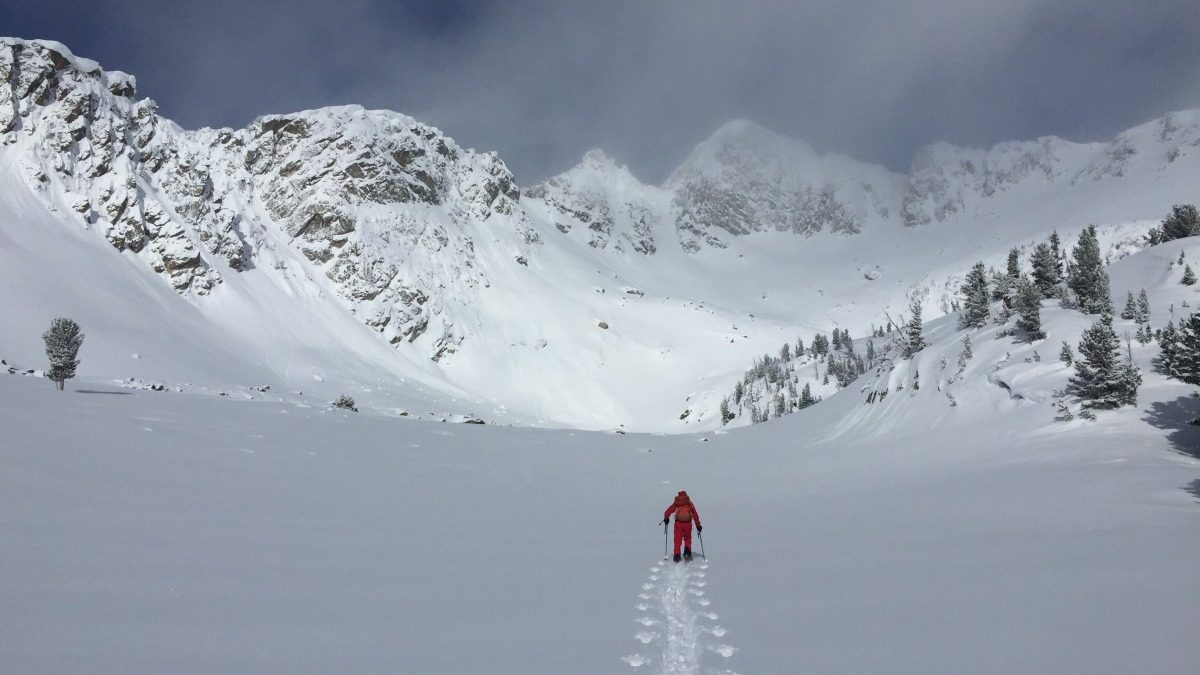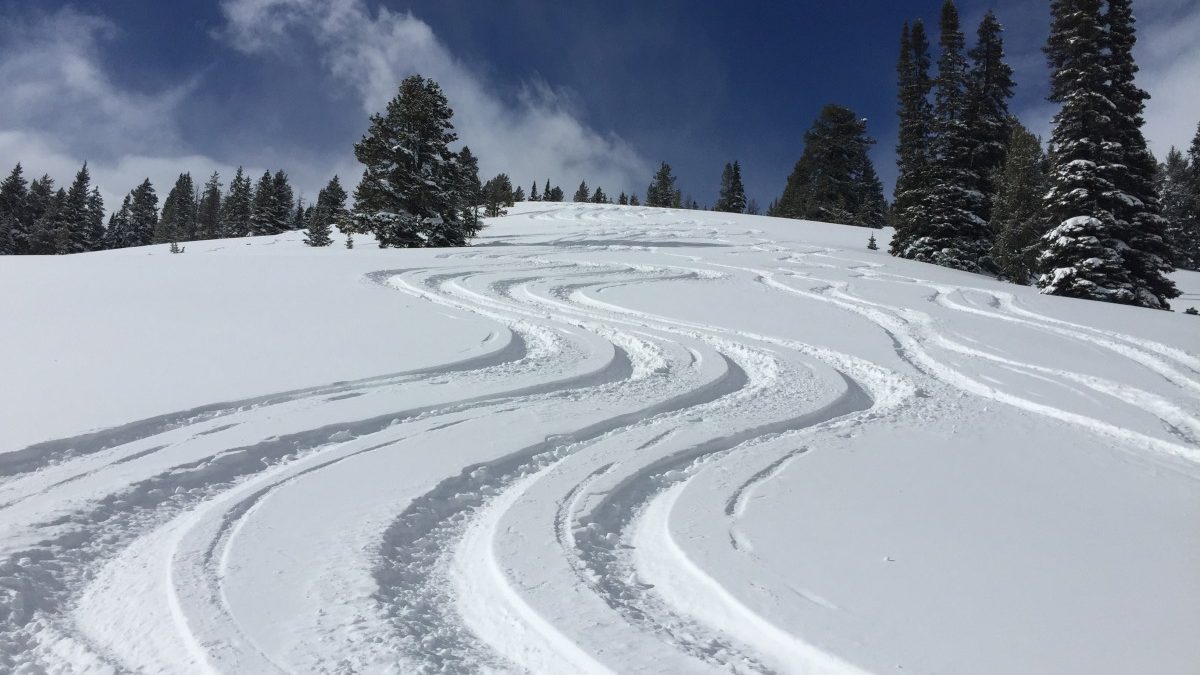
Many of us ski tour for the peace and solitude. That may be harder to find as ski touring becomes more popular, but a little attention to etiquette can go a long way. Beehive Basin, Northern Madison Range.
Written by Alan Crawford
The forecast is for overnight “snow showers” which normally means a large dump of cold powder. You contact your ski partners and make plans to ski a location the next morning that, based on the forecast, means breaking trail through 12+ inches of fresh. While your group started early, another group is ahead on the approach. After a couple hours of skinning, your group reaches the top of a perfect run. You note that the other group has focused on one area. However, as your group begins to ski what looked like an undisturbed area, you find that the other group has set a skin track that zig-zags across the middle of the fall line.
Spend enough time skiing in the backcountry and you’ve likely encountered a similar scenario. And as the sport of ski touring and split-boarding grows in popularity, you might encounter it even more.
Since the Coronavirus Pandemic began last March, we saw this growth skyrocket around my local southwest Montana slopes. I witnessed areas that only a few years ago saw limited travel can now almost have moguls from so many skiers. In recent years, there has been a lot of hard work and effort recently placed on avalanche education. Touring gear has become significantly better. What has not kept up with the explosive growth is teaching etiquette for travel in the backcountry.
I am 56 and grew up in one of the meccas of backcountry skiing – Western Kentucky! I saw my first ski hill in my early 20s in upstate New York, but ski touring didn’t take off for me until I moved to southwest Montana 16 years ago. As a latecomer to the fun of skinning uphill and sliding downhill, I will not be the person to give advice on the technique of skiing 45 degree icy couloirs or similar terrain. My ideas of a great day in the backcountry is skiing untracked powder in a meadow or through the trees under sunny skies in 15 degree temps solo or with my regular ski partners. The solitude, beauty of the mountains and lack of people are magical.
Luckily, one of my regular ski partners and friends has been touring for 40+ years. What I didn’t learn about avalanche safety, snowpack, route finding, terrain selection and etiquette during my ski-less Kentucky upbringing, I have gleaned from him. What follows is an incomplete list of considerations for the ski touring community to contemplate. I’m not trying to be the “backcountry etiquette police” but I think we can all agree that as the number of fellow backcountry travelers increases, we all need to pay more attention to how we treat each other and the snowy landscapes we frequent (in addition, of course, to avalanche safety, wilderness first aid and who has the lightest touring setup).
Access and rules
Most backcountry skiing, at least in the West, takes place on public lands. This is good but ‘public’ doesn’t mean everything is fair game all of the time. Keep in mind that winter wildlife closures go into effect in certain areas and some approach trails pass through private land via public easements. These rules need to be followed to the letter OR else we may lose access to a specific area due to the irresponsible actions of a few.
An example in southwest Montana is the access to Beehive Basin. This area offers a wide range of terrain from mellow meadows to narrow couloirs and everything in-between including a summer hiking trail that receives a lot of snow shoe use. The first mile or so passes through private land (multi-million dollar homes abound here due to the proximity to Big Sky). The landowners have granted year-round access via a trail until the Forest boundary is reached.
As you skin up this first mile, the open 25 – 30 degree meadows that are easily visible from the parking area and, also, the vacation homes, sure look tempting both in terms of terrain and ease of access. Unfortunately, it is common to see tracks along with kickers off the trail each season. There are numerous reports of poachers being ticketed by the local sheriff. As tempting as these areas look, stay on the trail and maintain a good relationship with the property owners. I am sure similar examples are found across the West.
And while I’m talking about rules, let’s consider mixed use trails. By mixed use, I am referring to groomed Nordic ski trails. It’s generally a good idea to stay off any groomed Nordic trail (and watch out for Nordic skiers [or snow shoers] who may not hear you coming). In some places, it may be difficult to stay off a groomed Nordic trail. In these areas, keep the side and by all means DO NOT ski over the classic Nordic tracks. If you decide to go snow shoeing, please set your own track instead of messing up the skin track.
Be nice
While it’s great to get away from the crowds of a ski resort and skin up your favorite area, it is inevitable, and more so now, that other people will have the same idea. On any given tour, you could encounter other ski tourers, Nordic skiers, snow shoers or, in the case of a place like Beehive Basin, the resort skier taking a day off and post holing up the skin track to take in the amazing views.
With any of these encounters, smile and say hi! A long discussion is not necessary, nor is revealing your special powder stash, but a friendly smile and hello goes a long way to make the day great.
Don’t litter
This should not need to be mentioned but here it is. This applies to the trailhead parking, skin tracks and transition areas. And yes, orange and banana peels count as litter! Litter also includes the water bottle or ski strap mistakenly left at the transition area – double check before you head down!
Oh, and for all those places where dogs are welcome, please pickup after your dog and please, please, pretty-please don’t leave the filled poop bag for a later “poop fairy” to retrieve. As anyone who has ever unwittingly run over it will tell you, dog poop is terrible skin or ski wax.
A final “don’t litter” comment – please don’t pee on the skin track, just next to the skin track, on the fall-line of a perfect ski run, in the trailhead parking area or in the middle of the uphill or downhill transition area. Be discrete — find a tree or bush. No one likes to navigate around yellow snow.
Mind your dog
Dogs are great! My little dog loves to go on short Nordic tours behind our house – porpoising through the powder is her idea of a fun time. A lot has been written about skiing with your dog – there are strong feelings and opinions on both sides of the coin. All I will say here is that as long as your dog is well behaved and does not come running across my line that I worked so hard on the uphill to ski, then dogs are great. If you can’t control your dog and your dog is interfering with other groups, then YOU need to make some changes. Finally, if you are planning a tour in a National Park (Yellowstone for example), leave your dog at home.
Fill in holes
Snow pits — formal, PhD snow science thesis style pits, forecaster style pits, hand pits, and the list goes on — are great, but please fill them in after you are finished. Please do not leave some gaping hole for a fellow backcountry skier or rider to “find” at the wrong time. The worst are pits that were not filled in and then collect blower powder from the next dump. If you’re going to take the time to dig the pit, take the time to fill it back in. The same goes for holes or snow-fort like structures that some of us like to “construct” at the transition point at the end of the uphill or as we prepare for the next lap. On your last run, please smooth these out.
Practice snow “management”
I am told that in the “good ole days”, you could ski a perfect powder filled meadow and come back to that same meadow a week later and the only tracks were your previous tracks. With some exceptions, these days are gone although with just a little more exploration, finding new “perfect powder filled meadows” is still possible.
A lot has been written about how to set the perfect skin track, i.e. how steep, how to follow the terrain contours and so on. In my opinion, the main thing to consider about a skin track is the safest, best location that stays out of prime skiable terrain! It is very frustrating to skin up the access of your favorite area after a large dump and find that someone has set a skin track right up the middle of the prime skiable terrain instead of skinning up the edge. Or, while a nicely located skin track may be too steep for some, the alternate is a track that zigs and zags all over the skiable terrain otherwise ruining a what would be untracked powder. Proper skin track location also avoids potential conflicts of uphill and downhill parties.
On the downhill part of the tour, it’s a good idea to practice good snow farming or, as one of my partners likes to do, figure-eight your partners tracks. Anything to preserve as much un-skied powder as possible. Remember, we work hard to get uphill and paying attention to overall run snow quality is really important — this isn’t the ski resort where no one seems to pay attention to where they ski (or traverse across the fall-line!).
Final thoughts
A final comment to consider is over-use of a specific popular area. As backcountry skiing and riding become more popular, the easy access areas are seeing a significant amount of traffic now versus even a few years ago. Nice runs are getting as tracked up as Bridger Bowl on a powder day. Consider the amount of traffic a specific area receives before planning your tour. I think it’s better to do some exploration instead of skiing a run that is already “skied out”.
Ski touring season will be here sooner than we think. Expect to see a lot of new faces in the popular places. Don’t be afraid to nicely call out when someone is bending the rules. Smile and remember we were all a “new face” at one time.
Alan Crawford was born in Kentucky but has lived in northern areas (upstate New York and southwest Montana) for half of his 56 years. He works as a consulting chemical engineer in the global silicone and high-pure silicon (solar and semiconductor) industries.
Beyond our regular guest bloggers who have their own profiles, some of our one-timers end up being categorized under this generic profile. Once they do a few posts, we build a category. In any case, we sure appreciate ALL the WildSnow guest bloggers!

